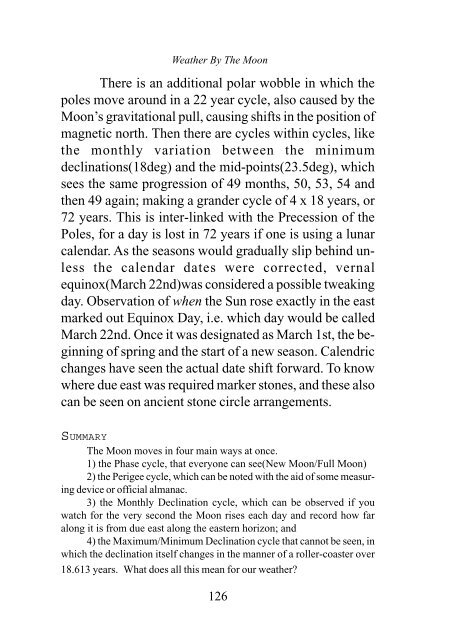Predicting Weather By The Moon - Xavier University Libraries
Predicting Weather By The Moon - Xavier University Libraries
Predicting Weather By The Moon - Xavier University Libraries
Create successful ePaper yourself
Turn your PDF publications into a flip-book with our unique Google optimized e-Paper software.
<strong>Weather</strong> <strong>By</strong> <strong>The</strong> <strong>Moon</strong><br />
<strong>The</strong>re is an additional polar wobble in which the<br />
poles move around in a 22 year cycle, also caused by the<br />
<strong>Moon</strong>’s gravitational pull, causing shifts in the position of<br />
magnetic north. <strong>The</strong>n there are cycles within cycles, like<br />
the monthly variation between the minimum<br />
declinations(18deg) and the mid-points(23.5deg), which<br />
sees the same progression of 49 months, 50, 53, 54 and<br />
then 49 again; making a grander cycle of 4 x 18 years, or<br />
72 years. This is inter-linked with the Precession of the<br />
Poles, for a day is lost in 72 years if one is using a lunar<br />
calendar. As the seasons would gradually slip behind unless<br />
the calendar dates were corrected, vernal<br />
equinox(March 22nd)was considered a possible tweaking<br />
day. Observation of when the Sun rose exactly in the east<br />
marked out Equinox Day, i.e. which day would be called<br />
March 22nd. Once it was designated as March 1st, the beginning<br />
of spring and the start of a new season. Calendric<br />
changes have seen the actual date shift forward. To know<br />
where due east was required marker stones, and these also<br />
can be seen on ancient stone circle arrangements.<br />
SUMMARY<br />
<strong>The</strong> <strong>Moon</strong> moves in four main ways at once.<br />
1) the Phase cycle, that everyone can see(New <strong>Moon</strong>/Full <strong>Moon</strong>)<br />
2) the Perigee cycle, which can be noted with the aid of some measuring<br />
device or official almanac.<br />
3) the Monthly Declination cycle, which can be observed if you<br />
watch for the very second the <strong>Moon</strong> rises each day and record how far<br />
along it is from due east along the eastern horizon; and<br />
4) the Maximum/Minimum Declination cycle that cannot be seen, in<br />
which the declination itself changes in the manner of a roller-coaster over<br />
18.613 years. What does all this mean for our weather?<br />
126





